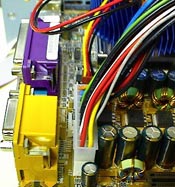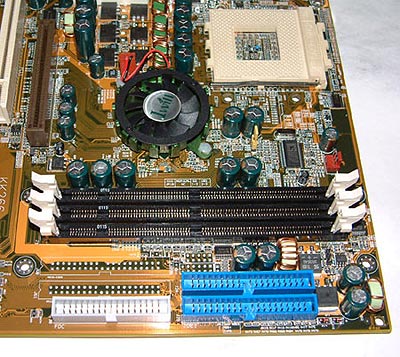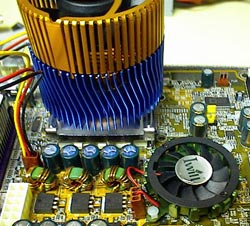So, what is the
difference between the KK266 and the KK266plus?
Well, the KK266plus
is built using stealth technology, and is undetectable by enemy radar. Errr...
no, forget we ever mentioned that - the real visible differences
between this, and the regular KK266 is the placement of the power
supply connector, and a change in PCB colour. There are also a few underlying
changes electrically speaking.
The first
thing that you'll notice on the KK266Plus is the presence of a snazzy new active
cooler on the northbridge. On closer inspection, there wasn't any thermal
material between the heatsink and northbridge! Sure it helps having a fan, but
thermal material would be nice, active cooler or not.
 Second thing
you notice, as we mentioned before is that Iwill decided to move the ATX power
connector closer to the MOSFET's. This change is supposed to provide
cleaner traces and a steadier power feed to the system
components.
Second thing
you notice, as we mentioned before is that Iwill decided to move the ATX power
connector closer to the MOSFET's. This change is supposed to provide
cleaner traces and a steadier power feed to the system
components.
I haven't ever experienced any stability problems with my old
KK266-R first hand, but I have noticed that my 5 Volt value goes as low as 4.6 V
when the processor is clocked at around 1.5 GHz.
I've heard that's not a very good condition to be in, but still even
with the changes I didn't like the fact the power cord has to drape over the
CPU's heatsink fan. It also somewhat difficult to remove
the ATX power cord because of it's close proximity to the onboard audio/gameport.
The general layout of the
KK266Plus is plain and clean - which is good!
There is one 4x AGP slot, six PCI's and an ISA for legacy devices. I
was very pleased IWill didn't included any AMR/CNR/ACR slots since they're really only useful to
OEM's.
If you haven't guessed from my
previous reviews, I have personal vendetta against CNR sockets - it's irrational I
know, but so are those slots. Anyway, moving on to the IDE and FDD
connectors....

The placement of the IDE and floppy drive connectors,
in my opinion, are perfect. When they are loaded up with ribbon cables everything will
be nicely out of the way, and off to the side.

Like it's predecessor, there is a lot of space around the CPU socket
- enough for me to install some of the larger heatsinks like the
Swiftech MC462A and the above Dragon Orb 3. Inside the CPU socket, dead center, is
a little thermal diode to take approximate temperature readings from the processor.
The only really annoying thing
about layout of components on the KK266Plus is something that has
become quite common with a lot of motherboards that have six PCI slots.
Namely, having to remove the video card to add more memory. That's the
price you pay for having six PCI's.
